Why Can't Skype Eliminate this Fraud?
Skype makes it possible to block calls from anyone who's not in your address book and if you don't need your Skype ID to be generally accessible, that's a good choice. Because of the way I use Skype (specifically the fact that I have a New York City phone number attached to the Skype account), I can't limit calls to just the people I know. So once or twice a day there's a call that purports to be an "urgent system notification" from Skype. It's nothing of the sort so I refuse the call and block the origination point. But like a game of whack-a-mole, the creeps who run the fraud call from another location.
The message is from a poor quality text-to-speech generator and it explains that the computer must be repaired. Of course it helpfully provides a URL for me to type into a browser. I haven't done that but an organization called SpywareRemove.com has and here's a video that they provide to show what can happen:
Dozens of these fraudulent "cleaner" scams exist. Maybe hundreds. But most use a Web-based pop-up. This is one that uses a different vector, Skype.
The URL cited in the video, "soshos.com", looks a lot like "sophos.com" and Sophos is a legitimate vendor. Connecting to any rogue site with a browser is dangerous, so I used a Windows PowerShell command to retrieve text from the site. I wasn't particularly surprised to find that the site had been shut down. As soon as one site is eliminated, another springs up on yet another hosting service.

Several years ago, I did follow one of these links intentionally with a browser but I was using a Mac and at that time the threat level for Macs was near zero. What was amusing at the time was that the computer scan reported hundreds of errors in the Registry (Macs don't use a registry structure) and said that many files in "C:\Windows" were infected (Macs don't have drive letters and, unless you've installed Windows using virtual machine software, there's also no Windows directory).
You can read the full SpyWareRemove report on this fraud on their website.
SpywareRemove.com is a security research center dedicated to providing up-to-date information on spyware and other types of malware. The organization's site says "SpwyareRemove.com's key role in the anti-spyware community is to identify and report spyware, trojans, rootkits and other malware threats, so you can securely and easily protect your computer from them. Malware creators are constantly changing their tactics to avoid detection. Therefore, you need to be on your toes when it comes to the newest forms of malware. Our efforts on malware research will serve as your guiding path into allowing you to make educated decisions on whether a program is considered malware (harmful) or has been verified as safe."
Good advice.
And to return to my opening question about why Skype can't eliminate frauds such as these: I don't know. The calls come from Skype accounts and I presume that once an account has been reported enough times, Skype closes it. These fraudulent operations always seem to have names that include terms such as "emergency" and "repair" so couldn't Skype watch for registrations that use these terms and then investigate? Or, when people sign up for an account, couldn't Skype require proof of identity? These actions wouldn't eliminate the frauds but they would make it harder for the fraudsters to set their traps.
How To Change the Windows 7 Logon Screen
This How To section is the first of what will be an occasional feature on TechByter Worldwide in which I'll share information about how to accomplish something that you might want to do but wonder how it's done. In some cases (today, for example) the topic will be frivolous but watch this space for useful how-tos on later programs.
The Windows 7 logon screen is fine and you probably see it for only a few seconds as you select a user name and provide a password but maybe you're tired of being greeted by a plain blue screen. If you want to change it, you can. Maybe you'd like a photo of your owner (the cat) or your friend (the dog) or your spouse instead of the plain blue screen. I did and here's how I made Windows show me what I wanted to see at logon.
WARNING! THIS INVOLVES EDITING THE REGISTRY. If that makes you uncomfortable or you don't know how to back up the Registry before editing it, then you should do one of the following:
- Don't proceed.
- Perform an Internet search to learn how to back up the Registry. This is really easy, so I recommend this step.
OK. So now you've backed up the Registry. Start the Registry Editor (WinKey, R, type "regedit", and press Enter). Accept the warning.
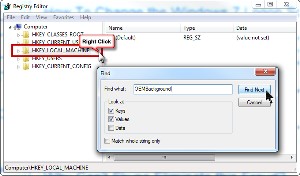 Some of the keys may be expanded if you've used the Registry Editor previously. Find HKEY_LOCAL_MACHINE in the left column and right-click it. Select Find and type OEMBackground in the dialog box that opens.
Some of the keys may be expanded if you've used the Registry Editor previously. Find HKEY_LOCAL_MACHINE in the left column and right-click it. Select Find and type OEMBackground in the dialog box that opens.
 After a few moments, this is what you'll find. Or maybe not. It's possible that the key doesn't exist on your computer. If it doesn't you'll need to create it. If you do need to create the key, drill down to:
After a few moments, this is what you'll find. Or maybe not. It's possible that the key doesn't exist on your computer. If it doesn't you'll need to create it. If you do need to create the key, drill down to:
\HKEY_LOCAL_MACHINE\SOFTWARE\Microsoft\Windows\CurrentVersion\Authentication\LogonUI\Background
and when you're there, select Background in the left panel and right-click it. Choose "New, DWORD value". Name the new key OEMBackground.
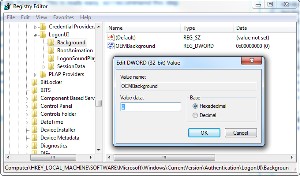 Now that you have located or created the DWORD OEMBackground key, double-click it in the right panel. The value will probably be 0 and you need to change that to 1. (In computer-speak, this is changing the value from "no" to "yes".) After making the change, click OK and close the Registry Editor.
Now that you have located or created the DWORD OEMBackground key, double-click it in the right panel. The value will probably be 0 and you need to change that to 1. (In computer-speak, this is changing the value from "no" to "yes".) After making the change, click OK and close the Registry Editor.
 You now need to create a location for the new background. Open the Windows Explorer and type (or copy/paste) the following into the address line: %windir%\system32\oobe (in most cases, this will translate to "C:\Windows\System32\oobe\" but use "%windir%" just to be sure.
You now need to create a location for the new background. Open the Windows Explorer and type (or copy/paste) the following into the address line: %windir%\system32\oobe (in most cases, this will translate to "C:\Windows\System32\oobe\" but use "%windir%" just to be sure.
Create a new directory called "info" (lower case) and then, inside that directory, create another directory called "backgrounds" (also lower case). You may find that these directories already exist. IBM, HP, and Dell computers usually have these directories. If you find that they already exist, that's OK.
Now you need to create the image that will appear on the logon screen. You'll place the image file in the "backgrounds" directory that you just created (or found). The file ...
- Must be named "backgroundDefault.jpg".
- Cannot be larger than 245KB.
- Should be the same ratio as your screen.
- Need not be the same size as your screen.
If those final two points seem contradictory, they're not. Here's what I mean. Let's say you have a wide screen monitor with pixel dimensions of 1920x1080 (that's the size of a high-definition video monitor). The image you create can be 1920x1080 pixels but an image that's 1000x563 will work equally well while an image that's 1000x800 will appear distorted.
If you use an application such as Adobe Photoshop to save the image to the backgrounds directory, Windows will refuse permission and suggest that you store the image elsewhere. That's OK. I have a "temp" directory on the desktop that I use for situations such as this. Store the file in any directory that you have access to. Then, using Windows Explorer, copy the new file to the backgrounds directory.
When you have the image in place, reboot the computer and enjoy your new logon screen!
Dreamweaver CS6 Packs New Features in a Familiar Interface
 At
first glance, you might think that Adobe Dreamweaver CS6 doesn't have much that's new to show you but the fact that the interface has changed very little disguises the numerous changes and improvements that lurk below the surface. So if you're still using an older version of Dreamweaver (or any version of Microsoft Front Page or its successor, Expression Web), now would be an excellent time to take Dreamweaver CS6 for a test drive.
At
first glance, you might think that Adobe Dreamweaver CS6 doesn't have much that's new to show you but the fact that the interface has changed very little disguises the numerous changes and improvements that lurk below the surface. So if you're still using an older version of Dreamweaver (or any version of Microsoft Front Page or its successor, Expression Web), now would be an excellent time to take Dreamweaver CS6 for a test drive.
Website developers can be divided into two groups: Those who sneer at visual interfaces and insist on coding sites using nothing more than a text editor such as UltraEdit and those who embrace the abilities provided by applications that allow visual interaction with the site. And maybe a third group has emerged: Those who know and are comfortable editing the underlying HTML, CSS, PHP, Perl, and Javascript but who appreciate the speed and control the visual interface gives them. Dreamweaver has functionality that all three types will enjoy.
The images in this section are from James Williamson's introductory program on Dreamweaver CS6 at Lynda.com. I highly recommend all of Williamson's instructional programs.
One important difference between Dreamweaver and Microsoft's website development tools is the fact that Dreamweaver runs under both Windows and OSX while Expression Web runs only under Windows.
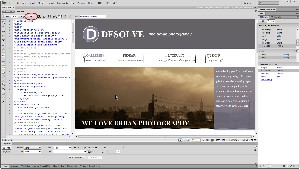 Adobe's decision to eliminate the Live Code and Inspect buttons unless Live View is selected is a tiny change that improves the interface considerably.
Adobe's decision to eliminate the Live Code and Inspect buttons unless Live View is selected is a tiny change that improves the interface considerably.
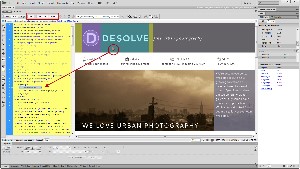 That's because Live Code and Inspect are meaningless unless the Live View is selected. Live View actually renders the page as it would be shown in a browser and, when Inspect is selected, hovering the mouse over any section of the page highlights the code in the Code panel.
That's because Live Code and Inspect are meaningless unless the Live View is selected. Live View actually renders the page as it would be shown in a browser and, when Inspect is selected, hovering the mouse over any section of the page highlights the code in the Code panel.
The Live Code view is also helpful if the page contains PHP code or any other code that must be generated on the fly by the server. In the normal Code View, you would see only the PHP code. Live Code makes the appropriate call to the testing server on your computer and returns the HTML code to the Code panel. When something isn't working right, this is a big time saver.
Note that you will need to install a testing server for the Live Code view to work but several free open-source options are available to do this.
A Grid for Your Page
The most significant improvement, though, is Dreamweaver's new fluid grid layouts. Grids have been an essential part of the design process for print designers since the earliest days of print design and now they've come to Web design.
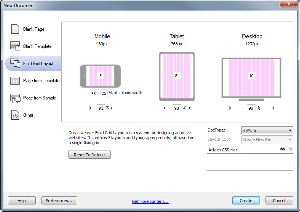 This is important for Web designers because the pages you create might be viewed on a large desktop monitor, a small tablet screen, or an even smaller smart phone screen.
This is important for Web designers because the pages you create might be viewed on a large desktop monitor, a small tablet screen, or an even smaller smart phone screen.
The grid is visible only during design and it varies depending on the screen size and your choice of how many columns should be in the grid and how large the gutter between columns should be.
When you create a fluid grid page, Dreamweaver automatically installs two files (boilerplate.css and respond.min.js) that are designed to ensure the best possible page rendering on all browsers, old and new, large and small.
 The illustration is from James Williamson's demonstration at Lynda.com
The illustration is from James Williamson's demonstration at Lynda.com
When viewed on a large desktop screen, the page will render with 3 columns. On a tablet, the page is re-arranged to fit in 2 columns and on a smart phone, everything will be in a single column.
The associated CSS automatically switches the layouts based on a media query statement.
As usual, Adobe has acquired some new business units that are designed to improve and extend the base applications. Acquisition of PhoneGap Build is one of these.
PhoneGap Build is an open-source platform that generates and returns to you a Web-based app that runs on both Apple's IOS platform and everybody else's Android platform.
The PhoneGap Build process is provided without charge.
Most website developers know how to use Web fonts to improve their sites' typography and Adobe now provides far more robust support for the @FONTFACE capabilities that has been developed to support typefaces. But Adobe has also acquired Typekit and developers who don't want to bother with the manual process of installing typefaces can use Typekit.

 Creating a Website? You Need Dreamweaver.
Creating a Website? You Need Dreamweaver.
Many years ago, when Adobe acquired Macromedia, I felt that this was a an acquisition with a lot of promise and it has proved to be just that. It's hard to imagine building a website with any other tools. Dreamweaver's code view, designer view, and live view work together to give any website designer the best of all worlds.
For more information, visit the Dreamweaver website.
Short Circuits
Think the LinkedIn Break-In Doesn't Affect You?
Think again! On June 26 I received more than 15 "reminders" from "Michael Costello" about my invitation to add him as a friend on LinkedIn. The clues that this was a fraud overflowed my inbox, fell onto the floor, and swirled around the wastebasket. Was this a surprise? Well, not exactly. But was it a result of the break-in at LinkedIn? Maybe not.
Here's an example of what reached my in box:
- The message was addressed to William Miller at ben.edu (Benedictine University, Lisle, Illinois), not to me.
- I received more than 25 copies of the same message and by the following morning the number had increased to 71 at which point they stopped. Here are the first 10.

- "Costello's" address was at a domain in Brazil.
- My LinkedIn inbox was shown to be at http://www.allegorie-romantisme.com/ (a website run by an artist who posts in French).
- The link provided to "adjust my e-mail notifications" is in India.
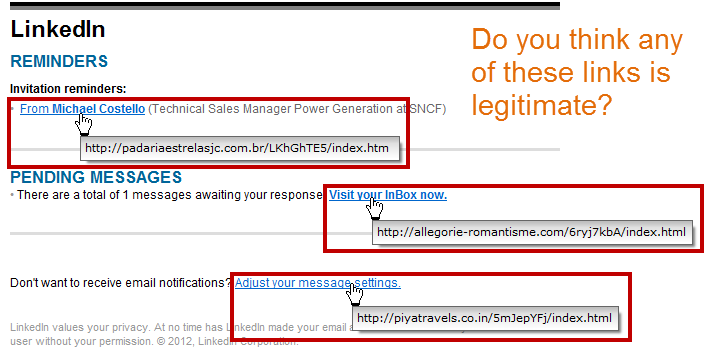
<sarcasm> Except for that, everything was completely believable. </sarcasm>
Don't be fooled by crap like this!
Photoshop Lightroom 4 Is in the Cloud
Adobe Creative Cloud is a membership-based offering that makes all of the company’s design, Web, video, and digital imaging tools available online for about $50 per month. Now that includes Lightroom 4.
Lightroom is designed to address the workflow needs of professional photographers but also works well for amateurs, particularly because most of the changes made by Lightroom are non-destructive. Lightroom makes it possible to import, manage, enhance, and share images. Adobe's Creative Cloud, new with version 6 of the company's Creative Suite, is what Adobe calls a "hub for making, sharing and delivering creative work."
Adobe vice president Winston Hendrickson says that the addition of Lightroom to Creative Cloud delivers on Adobe's promise to bring the best in Adobe innovation to Creative Cloud members. Adobe will continue to add new products and services to the Creative Cloud over the next few months, says Hendrickson. and the goal is to keep Creative Suite members up to date with the latest advancements in Adobe software and services.
Signing up for Creative Cloud gives members a predictable monthly fee that they can plan for and also provides access to the entire Creative Suite stable of applications. Additionally, Adobe promises to make updated applications available first to Creative Cloud members.
Adobe says that Creative Cloud gives subscribers "everything they need to create, publish, and share their work virtually anywhere with anyone."
Everything?
- Creative Cloud members can download and install any of the new Adobe Creative Suite 6 applications including the new Adobe Muse.
- The ability to create tablet-based apps with Adobe Touch Apps, including Photoshop Touch that allow users to create on a variety of tablets and further refine on the desktop.
- Twenty gigabytes of space to store and share content.
- Tools that allow users to create websites without writing code using Adobe Muse software and the option to host and manage up to five sites using Adobe Business Catalyst.
What Can Microsoft Buy for $1.2 Billion?
$1.2 billion in cash is what Microsoft will pay for Yammer, which will become part of Microsoft’s Office division. This is yet another foray in Microsoft's battle against competing social networks.
Yammer was founded in 2008 by David Sacks, who will continue to run the division under Microsoft. Sacks served as chief operating officer at PayPal.
Microsoft says that it plans to integrate Yammer into existing Office products and will also continue to make Yammer available separately. Yammer functions with both Iphone devices and Android devices. A Microsoft news release says that will continue to be the case.
The deal caused Microsoft stock to fall slightly.



 The author's image: It's that photo over at the right. This explains why TechByter Worldwide was never on television, doesn't it?
The author's image: It's that photo over at the right. This explains why TechByter Worldwide was never on television, doesn't it?
